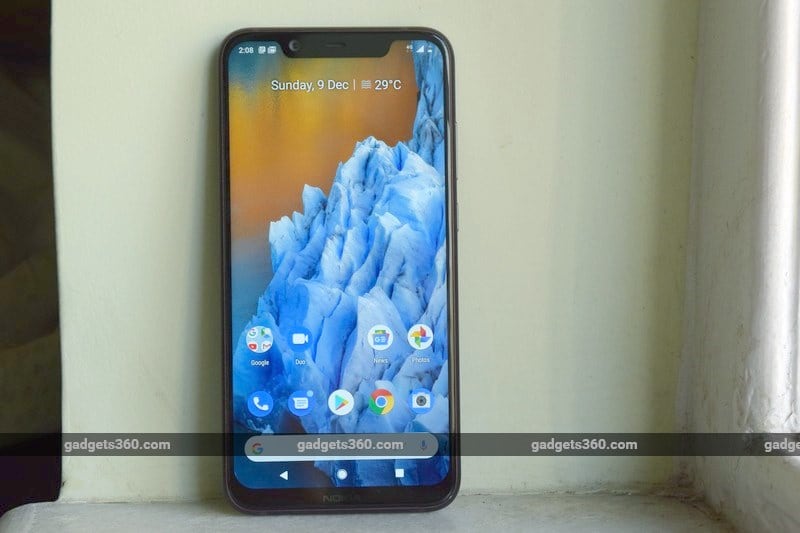

As if HMD Global’s number-and-decimal model hierarchy wasn’t confusing enough, there has been a course correction with the Nokia 8.1. This phone is not in any way meant to be superior to last year’s flagship Nokia 8 ₹ 25,990 or the Nokia 8 Sirocco ₹ 34,800 — from now on, flagship models will almost certainly make up a new 9-series tier. Instead, the new Nokia 8.1 is a premium model for those who don’t want to spend flagship-level money. Sure enough, there is a fairly wide gap in the market right now because thanks to relentless price wars, we now have a lot of sub-Rs. 20,000 phones with features that were considered impossible to find at that level just about a year ago.
However, the prices of premium phones have been coming down as well. We have the very strong Poco F1 ₹ 19,999 (Review) and Asus ZenFone 5Z (Review), as well as Samsung’s triple-camera Galaxy A7 (Review), which tempt buyers in the sub-Rs. 30,000 bracket with flagship-grade features. Has HMD Global judged the market correctly, and can the new Nokia 8.1 find its footing here? We’re about to find out.
Nokia 8.1 design
The Nokia 8.1 feels big, chunky, and heavy thanks to the materials and styling that HMD Global has gone with. The body is made of solid aluminium with glass on the front and rear. You have a choice of two colours — Blue/ Silver and Iron/ Steel — both of which have contrasting metal accents. Our review unit is the Iron version, which is more of a very deep plum purple, and is quite unusual. There’s a thick, flat band of highly polished steel running all around the sides. Visually, the band emphasises this phone’s 7.97mm thickness by splitting the body and interrupting the smooth curve of the sides. There are similarly shiny accents around camera bump and fingerprint sensor on the back.
On the positive side, the Nokia 8.1 is built like a tank. Every part of it feels completely solid, right down to the thick metal SIM tray and the power and volume buttons. The body doesn’t twist or flex even slightly. The glass on the front is an unspecified version of Corning Gorilla Glass, and HMD Global hasn’t confirmed whether the back is reinforced as well. Water and dust resistance would have been nice, but there doesn’t seem to be any IPxx rating.
The display notch is quite wide, and the earpiece, front camera, front flash, and proximity sensor are accommodated inside it. The chin isn’t too thick, but a reflective Nokia logo draws the eye there. On the back, the camera module bulges outward far more than what we’ve become used to seeing on phones like the OnePlus 6T. When lying on its back, the Nokia 8.1 rests on the camera bump and the glass surface barely makes contact with whatever is beneath it, which actually helps prevent it from sliding around.
Despite its proportions, the Nokia 8.1 is easy enough to grip. We were able to use it with one hand in some situations without worrying that it might slip and fall. Overall, while the material quality as well as the fit and finish of the Nokia 8.1 are excellent, it isn’t as slick or modern as some of its competitors.

Nokia 8.1 specifications and software
The most interesting thing about the Nokia 8.1 is that it isn’t meant to succeed the Nokia 8 (Review) or Nokia 8 Sirocco (Review), both of which were flagship devices using the once-flagship Qualcomm Snapdragon 835 processor. Instead, what we have is our first phone running the new Snapdragon 710, which is still meant to be premium, but not quite top-of-the-line. Qualcomm introduced the new 7xx series to address the fact that Snapdragon 6xx SoCs are now common in sub-Rs. 20,000 phones, leaving a huge gap between that level and the sole Snapdragon 8xx model of each generation.
The Snapdragon 710 supports high-end smartphone features with a dedicated AI subsystem, support for multiple high-resolution cameras, modern LTE modem, and of course beefy CPU and GPU cores. There are eight custom Kryo 360 CPU cores, but there’s a twist that the spec sheet isn’t clear about — two of these are Kryo 360 Gold cores (ARM Cortex-A75) running at up to 2.2GHz, and six are Kryo 360 Silver (ARM Cortex-A55) running at 1.7GHz. The Adreno 616 GPU is also claimed to deliver “console-like” gaming quality.
Another highlight of this phone is its HDR10-capable screen. It measures 6.18 inches from corner to corner and has an unusual 18.7:9 aspect ratio, which makes the resolution 1080×2246. There’s a 3500mAh battery, and “18W fast charging” is supported and you get a big 18W charger in the box, though HMD Global isn’t using the Qualcomm Quick Charge name.
There’s only one configuration option for the Nokia 8.1, with 4GB of RAM and 64GB of storage. That seems a little stingy, considering that 128GB is not uncommon at this price level. You can pop in a microSD card, but that means sacrificing a second SIM thanks to the hybrid dual-SIM design. Speaking of SIMs, 4G and VoLTE are supported on both. You also get Wi-Fi 802.11ac, Bluetooth 5, NFC, FM radio, and GPS. There’s a USB Type-C port on the bottom and a 3.5mm audio jack on the top.
[“source=gsmarena”]






